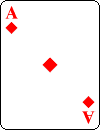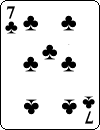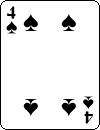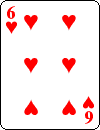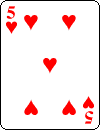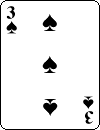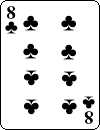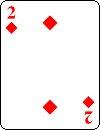Things to Come
Card Colm has appeared here more or less every two months since October 2004, with more than 52 columns now in the bag. As we approach the completion of its ninth year, we're also getting closer to North America's premier summer mathematics celebration, MAA MathFest.This year it's in Hartford, CT, and at the Recreational Mathematics: New Problems and New Solutions session there on Thursday, August 1, there's a talk on "Fitch Cheney's Five Card Trick for Four or Three Cards"—which is appropriate, as Cheney spent much of his professional life in the department of mathematics at the University of Hartford. The four-card version has been published twice by the MAA, here. The three-card take on this was developed on the way to MathFest 2012 in Madison last August, and was performed live there a few days later at the end of an MAA minicourse on mathematical card magic. The Hartford presentation will mark its debut with explanation. (It's scheduled to appear in Math Horizons in the first half of 2014.)
MathFest also sees the appearance of the 380-page full color Mathematical Card Magic: Fifty-Two New Effects (A K Peters), along with two book signing opportunities in the exhibtion hall (Thursday and Friday at 3pm). This volume actually contains more than 52 effects, along with an equal number of new mathemagical principles—but they are not in a natural one-to-one correspondence. Despite the coincindence of their also having been just as many Card Colms over the years, those aren't aligned with the effects in the book either. Yes, there is overlap—about three-quarters of the material?—but the book is organized differently, and is almost a grave of diamonds. It's also written for a more general audience and mostly eschews technical mathematical language.
Subtler Bracelets
In the June 2008 Card Colm Sum-Rich Circulants we continued a thread on bracelet beads started the previous year. Specifically, we focused on the g4g8 bracelet obtained by joining the ends ofHere's a good card incarnation:
| ||||||||||||||||||||||||||||||||||||||||||||||||||||||||||||||||||||||||||||||||||||||||||||||||||||||||||||||||||||||||||||||||||||||||||||||||||||||||||||||||
Here's the magic: plant these cards in order on the top of a deck and maintain them there throughout some fair-seeming shuffling, before dealing them face down in a circle. Have three adjacent cards peeked at and remembered by different spectators, while you turn away, and have those values summed. Upon being told this total you name all three selected cards. The reason is that this bracelet is sum-rich for triples: the eight possible sums of three adjacent card values are distinct. In fact, we get the numbers 17, 10, 12, 14, 16, 11, 13, 15, which are the eight consecutive numbers 10, 11, 12, ..., 17 in a special order.
This array first saw the light of day at the G4G8 conference in Atlanta in March 2008. Four years later, at the G4G10 conference, mathematician Steve Butler unveiled what we call the g4g10 bracelet, obtained by joining the ends of
Not only is this sum-rich for three adjacent beads, it's easily checked that it's also sum-rich for two adjacent beads. (The latter property doesn't hold for the g4g8 bracelet [8 5 4 1 7 6 3 2], as its double sums are 13, 9, 5, 8, 13, 9, 5, and 10.)
But wait, there's more: Butler's g4g10 bracelet is magical in a new and unanticipated way. The possible sums for adjacent triples and doubles are not only as large as they could be, as sets, they also have no overlap, being the sets {8, 12, 18, 24, 25, 23, 21, 17, 11, 6} and {4, 7, 9, 14, 19, 16, 13, 15, 10, 3}, respectively. Hence, in a card implementation as above, with 10 specific cards used and their suits memorized, you can deal these face down in a circle before turning away and asking that any two or three spectators select adjacent cards and reveal the value total to you. Without even knowing how many people were involved, you can reveal all. Pretty impressive, eh? Thanks to Steve Butler for sharing his wonderful discovery and allowing us to pass it on.
Dissociative Disorders
In the February 2008 Card Colm Additional Certainties, we broke rank with ordered beads on bracelets, abandoned the adjacency assumption, and considered sets such as {1, 2, 3, 5, 8, 13}, {1, 3, 4, 7, 11}, and {3, 4, 6, 8, 12}, which have the the property that if any two numbers from any one of them are added, then you can deduce what the numbers are from the total. In most cases it also works for three numbers, but it in general you'll also need to know how many values are being summed. For instance, if you are told that (Lucas) numbers from the second set sum to 8, but you don't know whether two or three were involved, then you're in trouble, as it could be 1 + 7 or 1 + 3 + 4. (In the June 2009 Card Colm Two Summer Difference Certainties, we extended these ideas to a wider class of sets, but the same ambiguity remained.)It's natural to ask if something like Butler's g4g10 bracelet exists in the set context, for card values. Let's go all the way and seek sets of k numbers in the range 1-13 with the property that all 2k-1 nonempty subsets have distinct sums. Trivial examples are {1, 2, 4, 8} (powers of 2) and {1, 3, 9} (powers of 3), and the more interesting {1, 3, 6, 13}, in which each value is 1 more than twice the previous one. There are many examples of size 4; find some more.
Now find one of size 5. How many such examples are there? Are there more if we relax the demands and only ask that the 2-sums and 3-sums be distinct (and all different from one another)? Can we find larger sets if we allow the use of negative numbers too (represented by Red cards, as opposed to Blacks for positive ones)?
The upshot is that once suits are also decided upon, five cards can be planted at the top of a deck—maintained there throughout some shuffling—then dealt face down in a circle, before you turn away and ask that any number of cards be peeked at and remembered. Once the sum is announced, you can figure out just how many numbers are involved, and then name all of the selected cards.
The existence of such sets of numbers—they are known in the business as dissociated sets—was brought to our attention earlier this month by Neil Calkin of Clemson University. More details can be found in the Coda of Mathematical Card Magic: Fifty-Two New Effects (A K Peters), to be published August 2013.
"Subtler" is an anagram of "Butler's" and "a grave of diamonds" is an anagram of "devoid of anagrams."

